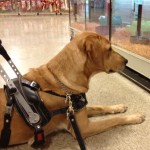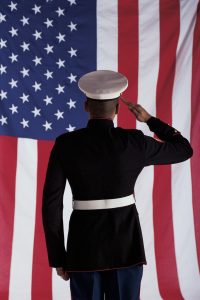Keeping the peace is a hard job. Since it's December 7—Pearl Harbor Day—I'd like to thank the men and women who've served in the U.S. Armed Forces, past or present.
Military veterans pay a huge price to protect America. Some lose their lives. Some come home with broken limbs or lost vision. Others return with the rhythms of war so deep in their bones that their normal lives don’t seem quite so normal any more.
Canine Americans are ready and willing to give back.
Ever heard of Paws for Patriots®? Until recently, I hadn’t heard of it either. It’s a program at Southeastern Guide Dogs. Paws for Patriots match guide dogs to veterans who have returned from the battlefield with wounds too deep to see.
You know how college students often change majors? Well, dogs can too. Most puppies enter guide dog school expecting to work with the visually-impaired. At Southeastern, puppies can switch to working with veterans.
Earlier this week, I interviewed one of the dogs from Paws for Patriots. I think you’ll enjoy what he had to say.

WILLIE: Welcome, Tracker. Thanks for joining me today.
TRACKER: No problem. I love talking about my job.
WILLIE: Okay, let’s begin with your training. What have you done so far?
TRACKER: It's been a lot of fun. First, I spent fourteen months with my puppy raisers. Then they brought me to Southeastern a few weeks ago for Guide Dog U Freshman Orientation. Now I’m working on my formal degree.
WILLIE: How will you decide what to major in?
TRACKER: The trainers help with that. They observe all the guide dog candidates for the first month of advanced training—to see where our aptitudes lie. Some of my classmates are definitely working toward careers with blind people. I’m pretty excited about switching to Veterans Assistance.
WILLIE: Are you saying all guide dogs at Southeastern start in the same training program?
TRACKER: Exactly the same. We start off with a physical. I didn’t like that part, but it’s really important to be healthy.
WILLIE: So true. You do a lot of walking.
TRACKER: I hear you. Then the trainers check out our personalities. You have to be polite, patient, obedient, and friendly. But not too friendly—which can be pretty difficult, I’m told. Kids really want to pet us.
WILLIE: I totally understand. Everybody wants my attention. I am that gorgeous.
TRACKER: Me too. It’s a burden.
[Heavy sighs in unison.]
WILLIE: So what happens next?
TRACKER: I have to learn my commands. There aren’t many of them. Maybe ten or so.
WILLIE: Dude, I had to learn forty.
TRACKER: You have to remember—my handler will be able to see. He or she will have a disability known as PTSD. Post-Traumatic Stress Disorder. So we’ll get to communicate through a different set of commands.
WILLIE: Like what?
TRACKER: Block is a good one. It’ll be my job to make sure people respect my handler’s personal space. Watch is the command that reminds me to watch his back. And hug—that’s my favorite. It means my handler needs my affection until his anxiety passes.
WILLIE: How much longer will you be in training?
TRACKER: Four to six months. It depends on who I’m matched with. My trainer is trying to find the perfect person for me. It’s a lifetime partnership, so she’s committed to getting this right.
WILLIE: Hey, dude, thanks for telling me and my faithful followers about your career. Would you be up to another interview in a few months—to let us know how things are going?
TRACKER: You know it. And thanks for having me.
Sounds like an amazing job, doesn’t it? I’m glad to know that career opportunities are expanding for service dogs. But even better, I’m glad that my four-legged friends can serve veterans with disabilities that aren’t immediately obvious to the general public.
We salute you, Men and Women in Uniform, for all the sacrifices you’ve made to keep America free.

In Memoriam
7 December 1941

3 Comments
Willie, what a great job you did interviewing Tracker!
I'm looking forward to your future interviews with Tracker.
Again, great job!
Great job, Willie and Tracker! I am in awe of both of you and the service and love you provide your people.
As the daughter of a veteran I appreciate your attention to those who have served in the military. And I am excited about the programs pairing dogs with veterans in need. I don't know how I'd get through the day without my furry companions!
Hey Willie and Tracker,
You might also want to alert your fans to a bill that has been passed by the US House and is coming up in the US Senate (S. 2134) called the Canine Members of the Armed Forces Act. The bill provides, among other things, establishing a system to provide for the lifetime veterinary care of retired, adopted military service dogs.
For more information,